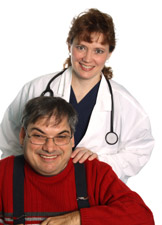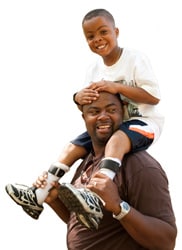Disability and Health Healthy Living
CDC’s Public Health Grand Rounds explored disability in health and practice.
Read the full article here.
View the December 2012 presentation.
People with disabilities need health care and health programs for the same reasons anyone else does—to stay well, active, and a part of the community.
Having a disability does not mean a person is not healthy or that he or she cannot be healthy. Being healthy means the same thing for all of us—getting and staying well so we can lead full, active lives. That means having the tools and information to make healthy choices and knowing how to prevent illness.
For people with disabilities, it also means knowing that health problems related to a disability can be treated. These problems, also called secondary conditions, can include pain, depression, and a greater risk for certain illnesses.
To be healthy, people with disabilities require health care that meets their needs as a whole person, not just as a person with a disability. Most people with or without disabilities can stay healthy by learning about and living healthy lifestyles.

Leading a Long and Healthy Life
Although people with disabilities sometimes have a harder time getting and staying healthy than people without disabilities, there are things we can all do to get and stay healthy.
Tips for leading a long and healthy life:
- Be physically active every day. Learn about physical activity.
- Eat healthy foods in healthy portions. Learn about nutrition.
- Don’t get too much sun. Learn about preventing skin cancer.
- Get regular checkups. Learn what health services and screenings may be good for you.
- Don’t smoke. Learn how to stop smoking.
- Use medicines wisely. Learn about medication safety.
- If you drink alcoholic beverages, drink in moderation. Learn about alcohol.
- Get help for substance abuse. Find treatment services near youexternal icon.
- Stay in touch with family and friends.
- If you need help, talk with your health care professional.
For more information:
Current Cigarette Smoking Among Adults — United States, 2005-2014: According to the report, smoking prevalence higher among those reporting having a disability compared with those who reported no disability.
Health care reform for Americans with disabilities: Learn more about the Affordable Care Actexternal icon.
Getting the Best Possible Health Care
People with disabilities must get the care and services they need to help them be healthy.
If you have a disability, there are many things you can do to make sure you are getting the best possible health care:
- Know your body, how you feel when you are well and when you’re not.
- Talk openly with your health care professional about your concerns.
- Find health care professionals that you are comfortable with in your area.
- Check to be sure you can physically get into your health care professional’s office, such as having access to ramps or elevators if you use an assistive device like a wheelchair or scooter.
- Check to see if your health care professional’s office has the equipment you need, such as an accessible scale or examining table.
- Ask for help from your health care professional’s office staff if you need it.
- Think about your questions and health concerns before you visit your health care professional so that you’re prepared.
- Bring your health records with you.
- Take a friend with you if you are concerned you might not remember all your questions or what is said by the health care professional.
- Get it in writing. Write down, or have someone write down for you, what is said by the health care professional.
Physical Activity
Adults of all shapes, sizes, and abilities can benefit from being physically active, including those with disabilities. For important health benefits, all adults should do both aerobic and muscle-strengthening physical activities. Regular aerobic physical activity increases heart and lung functions; improves daily living activities and independence; decreases chances of developing chronic diseases; and improves mental health.
Adults with disabilities should try to get at least 2 hours and 30 minutes (150 minutes) a week of moderate-intensity aerobic physical activity (i.e., brisk walking; wheeling oneself in a wheelchair) or at least 1 hour and 15 minutes (75 minutes) a week of vigorous-intensity aerobic physical activity (i.e., jogging, wheelchair basketball) or a mix of both moderate- and vigorous-intensity aerobic physical activities each week. A rule of thumb is that 1 minute of vigorous-intensity activity is about the same as 2 minutes of moderate-intensity activity. They should avoid inactivity as some physical activity is better than none.
Muscle-strengthening activities should include moderate and high intensity, and involve all major muscle groups on two or more days a week (i.e., working with resistance-band, adapted yoga) as these activities provide additional health benefits. All children and adolescents should do 1 hour (60 minutes) or more of physical activity each day.
If a person with a disability is not able to meet the physical activity guidelines, they should engage in regular physical activity based on their abilities and should avoid inactivity. Adults with disabilities should talk to their healthcare provider about the amounts and types of physical activity that are appropriate for their abilities.

Tips for getting fit:
- Talk to your doctor about how much and what kind of physical activity is right for you.
- Find opportunities to increase physical activity regularly in ways that meet your needs and abilities.
- Start slowly, based on your abilities and fitness level (e.g. be active for at least 10 minutes at a time, slowly increase activity over several weeks, if necessary).
- Avoid inactivity. Some activity is better than none!
To learn more on physical activity among adults with disabilities:
CDC Disability and Physical Activity
Healthy Weight & Obesity Briefs
Abuse and Violence of People with Disabilities
People with disabilities are at greater risk for abuse, violence, and harm than people without disabilities. This is called victimization. Victimization is harm caused on purpose. It is not an “accident” and can happen anywhere. The two most common places where victimization occurs are in hospitals and homes.
“For some years, I could not stand up or stretch my arms above my head. I had to use a walker. My wife and I started using a fitness club regularly. Now, I can again walk upright and stretch my arms over my head. It’s made a difference in my life, like being able to put the dishes in cupboards.”
Victimization includes:
- Physical violence with or without a weapon.
- Sexual violence of any kind, including rape.
- Emotional abuse, including verbal attacks or being humiliated.
- Neglect of personal needs for daily life, including medical care or equipment.
In the United States, people with disabilities are 4 to 10 times more likely to be victimized than people without disabilities. Children with disabilities are more than twice as likely to be victimized as children without disabilities. Researchers found that 11.5% of adults with a disability were victims of sexual assault vs. 3.9% of adults without disabilities. In addition, 13.0% of people with disabilities were victims of attempted sexual assault compared to 5.7% without disabilities.123
Victims usually know the person who harms them. They can be health care workers, intimate partners, or family members. More men than women cause harm to people with disabilities. If you or someone you love is being victimized, there is help available.
- Dial 911 if you need immediate assistance.
- Call the National Domestic Violenceexternal icon hotline at:
- 1-800-799-SAFE or TTY 1-800-787-3224
For more information:
CDC’s National Center for Injury Prevention and Control
List of organizations working to prevent victimization
Sexual Health and Sexuality
Health care professionals and people with disabilities should feel comfortable talking to each other about sexual health and sexuality. People with disabilities can ask their doctor questions about sexuality, sexual functioning, contraceptives, and reproductive concerns.
For more information:
Tips for Communicating with Female Patients with Intellectual Disabilities (ID)
Mental Health and Well-Being
For everyone, overall mental health and well-being is very important. Mental health is how we think, feel and act as we cope with life. People need to feel good about their life and value themselves.
All people, including those with disabilities might feel isolated from others, or have low self-esteem. They may be depressed. There are different ways to treat depression. Exercise may be effective for some people. Counseling, medication, or both might also be needed.
Everyone feels worried, anxious, sad or stressed sometimes. If these feelings do not go away and they interfere with your daily life, you should talk with other people about your feelings, such as a family member or health care professional.
For more information:
Teen Mental Healthexternal icon
Adult Mental Healthexternal icon
Leading a Long and Healthy Life pdf icon[737 KB, 9 pages]
References
- Petersilia JR. Crime victims with developmental disabilities: a review essay. Criminal Justice & Behavior 2001;28(6):655–94.
- Sobsey D, Mansell S. An international perspective on patterns of sexual assault and abuse of people with disabilities. International Journal of Adolescent Medicine & Health 1994;7(2):153–78.
- Centers for Disease Control and Prevention (CDC). Behavioral Risk Factor Surveillance System Survey Data. Atlanta, Georgia: U.S. Department of Health and Human Services, Centers for Disease Control and Prevention, 2006.
